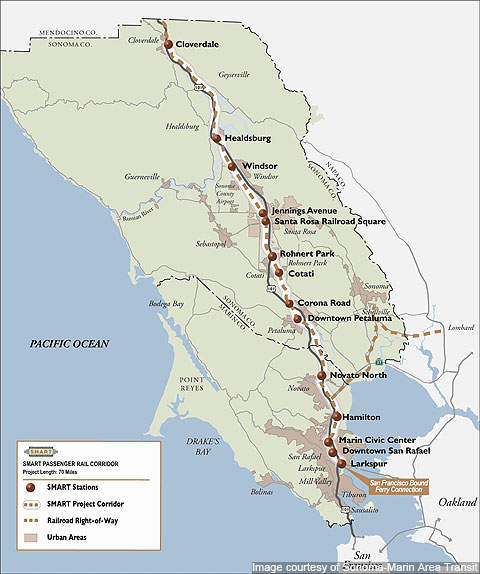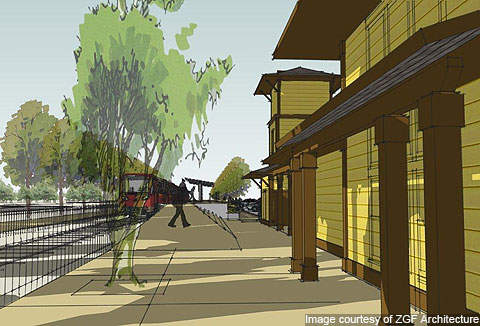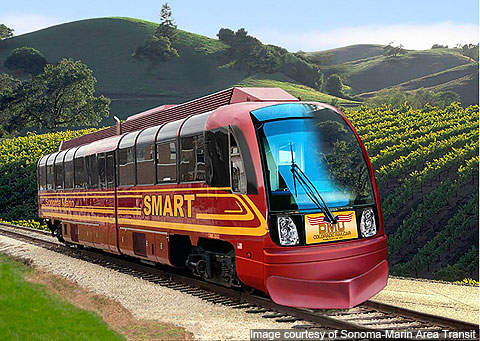The Sonoma-Marin Area Rail Transit District (SMART) is constructing a 70-mile passenger rail road along the existing Northwestern Pacific Railroad (NWP) right-of-way (ROW) in the North Bay corridor of California. The NWP is owned by the North Coast Railroad Authority (NCRA).
The project also includes the construction of a bicycle / pedestrian path parallel to the railway line. The rail line and bicycle / pedestrian path will pass through two counties in North Bay, California – Cloverdale in the north of Sonoma County, and Larkspur in Marin County.
The Sonoma-Marin rail transit project aims to provide multi-modal and fuel efficient alternatives to reduce traffic congestion on Highway 101, the only north-south transportation facility in North Bay.
Around 80% of the commercial, educational and residential facilities in North Bay are located on this corridor.
The project is expected to reduce car trips on the highway by 1.3 million and offset greenhouse gases by 124,000lb a day.
The project’s feasibility studies and environmental impact certification were completed in 2006 with the assistance of Louis T. Klauder and Associates Engineering Services (LTK).
The supplemental environmental impact report (EIR) was certified in 2008. The contracts for the design and engineering of the 14 train stations valued at $11.3m were approved in December 2009. The main contractor is Winzler & Kelly.
The SMART project was originally estimated to cost $590m, but by the end of 2010 this had risen to $695m. The project is being financed through local sales tax revenues, regional bridge toll funding, and state and federal funds.
Sales Tax Measure Q, which is a 0.25% increase in sales tax, will fund 60% of the project. Measure Q was approved by 69.6% of the voters in Marin and Sonoma counties during the elections on 4 November 2008. However, due to a $350m deficit in sales tax revenues, SMART decided to build the project in stages. The decision taken in November 2010 is expected to delay the service’s launch by between two and four years.
The construction of the project is expected to commence in 2011. Phase one will involve a 40-mile route between Railroad Square in Santa Rosa and Marin Civic Centre in San Rafael, and cost of $395m. Services are scheduled to begin in 2014.
Sonoma-Marin rail transit project details
The project is expected to provide a seamless transportation network of buses, ferries, bike paths and side-walks connected to a centralised rail line.
The project includes the re-laying of the tracks, the construction of a maintenance facility on either of the two stops (Cloverdale or Windsor), the reconstruction of two tunnels, 59 bridges and the operation of 14 stations – nine in Sonoma County and five in Marin County.
Stations in Sonoma County are Cloverdale, Healdsburg, Windsor, Santa Rosa, Santa Rosa Railroad Square, Corona Road (Petaluma) and Downtown Petaluma. Marin County stations include Novato North, Novato South, Marin Civic Center, Downtown San Rafael and Larkspur.
Two rounds of public workshops were conducted in February and April 2010 to take public opinion on the design and amenities required at the stations. The aim was to cater to all the needs of different communities living along the corridor.
The commuter service trains will operate at a 30-minute interval in the peak hours (morning and evening) during week days, making 14 round trips and a 30-second wait at each station.
According to environmental studies on the SMART project, around 5,300 passengers per day will utilise the commuter service, while the bicycle / pedestrian service will attract another 7,000 to 10,000 people per day. There will be a provision for boarding bicycles on the train.
Rail transit infrastructure
Stations along the corridor will be designed to accommodate existing feeder buses and shuttle services, along with park and ride facilities in a few selected suburban stations. In order to further reduce congestions in Santa Rosa, Pataluma and San Rafael cities in the downtown areas of the North Bay, stations at these places are being designed with no park and ride facilities.
The bicycle-pedestrian pathway will have 54 miles of Class I pathway and 17 miles of Class II pathway improvements. The Class I pathway is a separate and exclusive path for bicycles and pedestrians with minimised cross flow. Class II is a small lane for one-way travel.
There are two existing tunnels in the project corridor – Puerto Suello Hill Tunnel at San Rafael and Cal Park Hill Tunnel between San Rafael and Larkspur. These tunnels will be rebuilt to a 1,000ft length with adequate lighting, ventilation and water lines for fire protection.
Most of the 59 bridges are timber open deck or timber ballast decks. These will be replaced with concrete decks.
Sonoma-Marin area rail transit rolling stock
The Sonoma-Marin area rail transit will use heavy diesel multiple unit vehicles in this route. Diesel multiple unit vehicles have engines installed under the passenger compartment, which eliminates the need for large locomotives.
Sumitomo Corp was awarded the rolling stock contract in December 2010. Valued at $56m, the contract includes the delivery of 18 cars as nine two-car train sets. The first train is expected to be delivered in October 2013 with delivery of the final train to take place by May 2014.
SMART has an option to add a middle car to provide two-car sets as the ridership grows.
The trains are expected to maintain an average speed of 46mph. These sets will have a dual cab facility that will allow the trains to run in reverse direction as well as avoid the need for turnarounds.
Each two-car train set will have 158 seats, and 24 primary and 14 secondary bicycle parking spaces. The trains will have work tables and luggage racks. Other features will include a Wi-Fi connection and reclining seats. All trains will be compliant with Americans with Disabilities Act.
Sonoma-Marin rail transit signalling and communications
Signalling is based on the automatic block signalling concept that allows the train to operate at a speed of 80mph. A block signal has a combination of track switches that are interconnected to avoid conflicting train movements. The automatic signals ensure the safe movement of trains travelling in the same direction.





